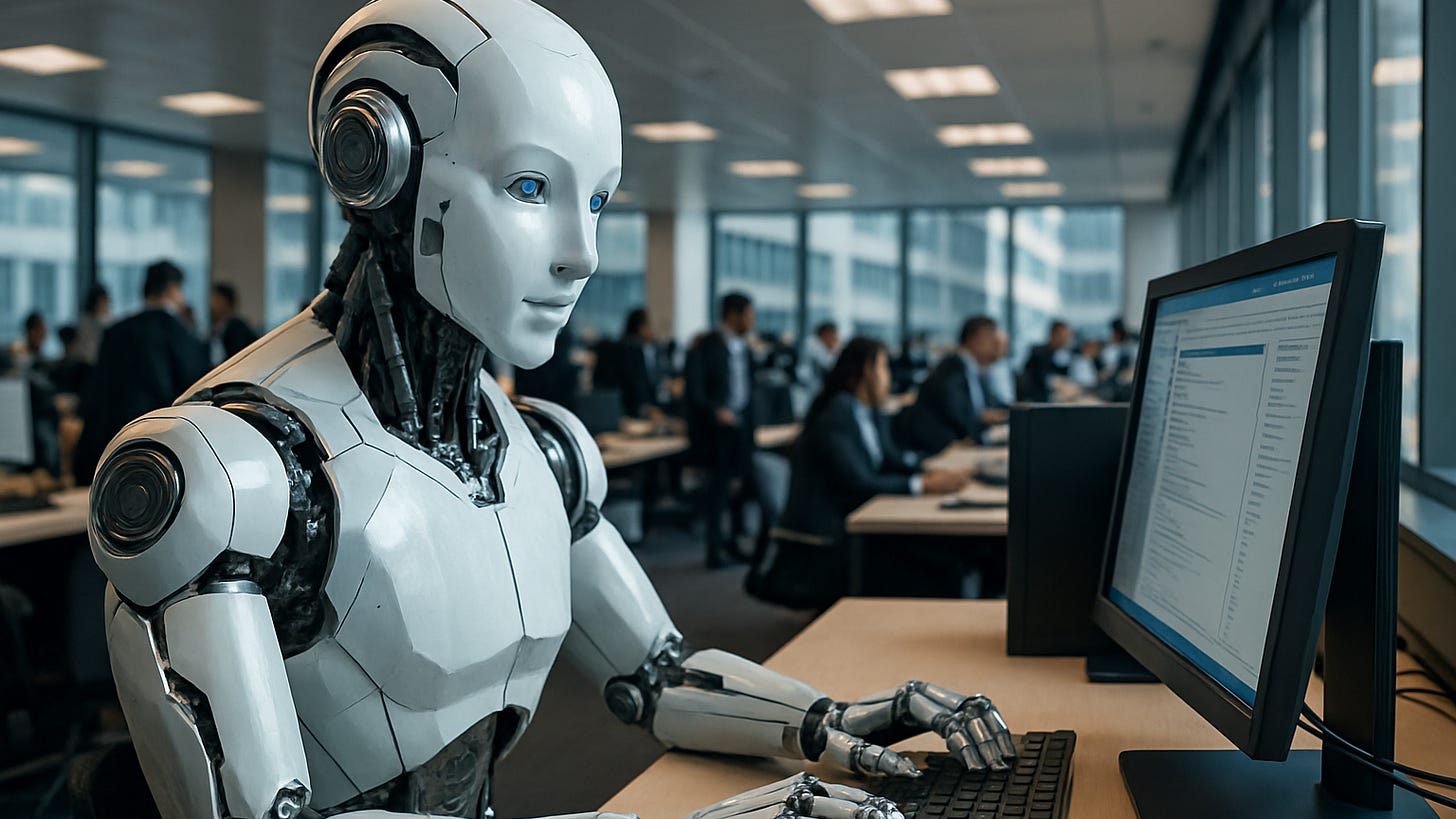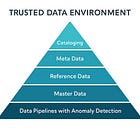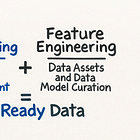AI Isn’t Coming for Your Job—It’s Coming for Your Workflow
Digital Workers or Human Workers, your systems need to be strong to ensure inputs and outputs can be trusted!
📌 THE POINT IS: AI agents aren’t going to replace all of your workflows and applications. They’re going to use them just like your human workers do. The question isn’t if they’ll show up in your business, but whether your data and application foundations are ready for them. This piece explores what agents can actually do today, where the technology is heading, and why companies should invest in input controls, clean data pipelines and observability if they want to benefit.
The reality check: what AI agents are doing today
Open any social feed and you’ll see breathless predictions that AI will replace swathes of knowledge workers. That isn’t what’s happening on the ground. Agents are being hired like junior colleagues, not CEOs. In Phase 1, they remove drudgery by acting as assistants; in Phase 2, they join teams as digital colleagues, taking on specific tasks with human direction; only in Phase 3 do humans set direction and let agents run entire workflows2. According to Microsoft’s 2025 Work Trend Index, 82% of leaders say this year is pivotal to rethink operations for AI, and 81% expect agents to be moderately or extensively integrated into their company’s AI strategy within the next 12–18 months2. One quarter of companies have already deployed AI organization‑wide2.
Where are these agents working? A 2025 survey of thousands of Substack posts found that AI and software development trends rank among the platform’s fastest‑growing narratives3, reflecting how quickly agentic AI is infiltrating mainstream discourse. In practice, however, AI agents are being used for very specific workflows:
Meeting summarization and goal management. Tability’s 2025 review notes that AI agents summarize meetings, launch marketing campaigns and manage internal goals, taking on tasks that were once manual or hard to keep up with1. They free up time while never sleeping, scaling instantly and learning fast1.
Personally, I really enjoy letting M365 Co-Pilot join meetings in Teams and later provide a summarization of the notes and action items. Sure it’s not 100% perfect all of the time, but it’s really good and for me, that’s enough. When you learn that you can stop and restart transcriptions to create separate note packages for different sections of your meeting, now you’ve discovered a great way to have specific, sharable assets about discussions with almost no extra work!
Business process automation for SMBs. An in‑depth guide on AI agents for small businesses highlights that SMBs use agents to handle customer inquiries, manage inventory, track finances and generate marketing content4. These agents often come embedded in SaaS tools, meaning many entrepreneurs are already using AI without realizing it4. AI‑as‑a‑Service offerings and low‑code tools have lowered barriers so dramatically that 50% of SMBs are expected to adopt at least one AI automation solution by 20264.
This also translates to my world, even though I work for a larger enterprise. Many of our SaaS and other vendor-solution partners are offering agents or other natural language, graph DB, or Knowledge Graph offerings within their ecosystems. This is starting to change how we think about future tech investments when the in-built DataBricks agent can scan its whole environment, pull out answers to questions in natural language, and even provide a graph to you in real time!
“When we think about, even, all these agents, the fundamental thing is there's a new work and workflow. So, the new workflow for me is: I think with AI and work with my colleagues.” - Satya Nadella
The takeaway is that today’s agents are augmenting work more than replacing it. Lower‑level employees might now “manage” several AI agents1, but human judgment sets goals and resolves edge cases. A Stanford survey of U.S. workers showed that 46.1% of tasks were ones employees wanted automated6, primarily to free up time for higher‑value work. Importantly, 45.2% of occupations favored an equal partnership with AI (the Human Agency Scale’s H3 level), not full automation6. This underscores that collaboration rather than replacement is the prevailing desire.
The digital worker won’t replace your systems
Many discussions around agents make it sound like we’ll rebuild entire workflows as end‑to‑end AI services. Yet most business logic already lives in existing applications, from CRM and ERP systems to custom line‑of‑business software. The smarter approach is to train agents to interact with these systems utilizing MPC or other API protocols so that the application doesn’t care whether a human or a digital worker is clicking buttons. This preserves business rules, audit trails and security controls while unlocking automation.
Microsoft’s Frontier Firm model describes a progression where hybrid teams of humans and agents scale rapidly by blending machine intelligence with human judgment2. Meanwhile, small‑business surveys show that most practical agents today are rule‑based or lightweight learning agents integrated into SaaS platforms to handle repetitive tasks4. These agents don’t rewrite enterprise logic; they safely orchestrate actions across existing systems.
Preserving existing logic also minimizes regulatory risk. Over‑automation—replacing human interaction where empathy or expertise is critical—is identified as a top pitfall in SMB adoption4. Another frequent mistake is poor data hygiene: deploying predictive agents without clean, consistent historical data leads to inaccurate outputs4.
Data readiness: the backbone of agentic success
The most sophisticated AI agent will fail if it’s fed junk7. Gartner has declared Agentic AI the #1 strategic technology trend for 2025 and predicts that by 2028 at least 15% of day‑to‑day work decisions will be made autonomously7. However, Gartner warns that “dazzling proofs of concept will not appear without a strong data foundation”7. Data readiness is mission‑critical: quality, accessible, well‑governed data must underpin every AI agent7.
“Data is the nutrition of artificial intelligence. When an AI eats junk food, it's not going to perform very well.” - Matthew Emerick
I’ve talked a lot in this newsletter about the trusted data environment, but this just underscores that if you don’t take care to build a strategy where you can trust the data coming in and being utilized by both humans and machines, you’ll simply open your company up to incalculable risk. It’s no longer OK to bypass the input control, data pipeline, observability, or pipeline development projects like we used to. Waiting for a downstream reporting or data science team to clean up inputs is way too late and way too slow for AI, especially when digital workers are interacting with your front-end systems.
To dive into more details, check out these articles on dAIta POINTS today:
“You can have all of the fancy tools, but if your data quality isn't good, you're nowhere.” - Veda Bawo
These steps aren’t academic nice‑to‑haves; they’re survival traits. Research shows analysts spend up to 80% of their time simply finding and cleaning data7. Without addressing fragmentation, stale information and missing metadata, AI agents will misinterpret inputs, hallucinate or make costly mistakes.
“People spend 60% to 80% of their time trying to find data. It's a huge productivity loss.” - Dan Vesset
The market signals: invest now or fall behind
Why invest in all this plumbing? Because digital labor is about to close a gaping productivity gap. Microsoft’s survey found that 53% of leaders say productivity must increase, yet 80% of employees feel they lack time or energy to do their work2. Intelligence on tap—AI and agents that can reason, plan and act—allows companies to scale capacity on demand2. Leaders are confident: 82% expect to use digital labor to expand workforce capacity in the next 12–18 months2.
The economic opportunity is enormous. The global AI agents market, valued at $5.9 billion in 2024, is projected to grow from $7.7 billion in 2025 to $105.6 billion by 2034, a compound annual growth rate of 38.5%12. Top investment areas include customer service (38%), sales and marketing automation (32%), financial analytics (19%) and operations/supply chain (11%)4. Moreover, 81% of leaders expect agents to be integrated into their AI strategy within 12–18 months2. Put simply: if you’re not preparing your work environment for agents now, you’re leaving money and efficiency on the table.
Building your digital workforce: practical recommendations
1. Start with the human, not the agent. Identify tasks that employees want automated and where automation adds value. Research shows workers favor automating low‑value, repetitive tasks6 but prefer equal partnership on higher‑value work6. Over‑automating tasks requiring empathy or expertise can backfire4.
2. Preserve and extend existing systems. Don’t throw out your ERP or CRM. Train agents to interact with them, preserving business rules and audit trails. Leverage agents for coordination, leaving core logic intact. Use multi‑party computation (MPC) or secure protocols so that both humans and digital workers can access systems safely.
3. Invest in data foundations. Unite your data silos through a semantic layer7, enforce data quality and freshness7, and enrich metadata and lineage7. Implement real‑time pipelines and monitoring tools that summarize telemetry into AI‑ready insights9. Adopt data quality management practices, business rules and continuous profiling10.
4. Build guardrails and governance. Establish access controls, content filters and alignment parameters before deploying agents7. Restrict agents to approved datasets and mask sensitive identifiers7. Use prompt‑level safeguards to prevent hallucinations and ensure compliance.
5. Upskill your workforce. Equip employees to manage and collaborate with digital coworkers. Provide training in prompt engineering, data literacy and high‑level oversight. Encourage employees to think like product managers for their agents—setting goals, monitoring performance and refining workflows.
6. Measure and iterate. Pilot agents in a single department, track performance metrics (time saved, error rates, satisfaction) and iterate4. Expand gradually as ROI becomes clear.
Why this matters now
In today’s world, the AI revolution isn’t about replacing humans; it’s about amplifying human capacity.
“AI is not going to replace humans [in the short-run], but humans with AI are going to replace humans without AI.” - Karim Lakhani13
Agents will increasingly take on the boring, repetitive and data‑driven parts of our jobs so that people can focus on strategy, creativity and relationships. But this future isn’t guaranteed. Without clean data, observability and guardrails, agents will amplify chaos instead of productivity. Your digital workforce will only be as good as your data foundation.
References
Tability’s 2025 review of AI agents highlights that digital coworkers summaries meetings, launch marketing campaigns, manage goals and free up time by handling repetitive tasks tability.io. It also notes that employees now manage multiple AI agents and that tools such as Relevance AI and CrewAI enable building teams of delegated agents tability.io tability.io.
The 2025 Microsoft Work Trend Index describes three phases of AI adoption—assistants, digital colleagues and autonomous agents—and reports that 82% of leaders see 2025 as pivotal for rethinking operations. It notes that 81% expect agents to be integrated into their strategy within 12–18 months, and 25% of firms have already deployed AI organization‑wide microsoft.com microsoft.com microsoft.com. The report also highlights that 53% of leaders need productivity to increase while 80% of employees lack time and energy, and that leaders plan to use digital labor to expand capacity microsoft.com microsoft.com.
A 2025 analysis of trending Substack posts shows that AI and software development topics are among the fastest‑growing narratives on the platform britopian.com.
A small‑business guide to AI adoption notes that SMBs use agents to handle customer inquiries, inventory, finances and marketing content aalpha.net and that many tools embed AI by default aalpha.net. It warns against over‑automation, poor data hygiene and underestimating task complexity aalpha.net and projects that 50% of SMBs will adopt at least one AI automation solution by 2026 aalpha.net. The report estimates the SMB AI market will grow from USD 3.7 billion to over USD 20 billion by 2030 and lists top investment areas aalpha.net.
In a 2025 interview, Microsoft CEO Satya Nadella said that AI agents will redefine how knowledge work is performed, noting that “there's a new work and workflow” and that he personally “thinks with AI and works with [his] colleagues” businessinsider.com.
A Stanford survey of U.S. workers found that 46.1% of tasks were ones employees wanted automated and that 45.2% of occupations preferred equal partnership with AI—the Human Agency Scale’s H3 level arxiv.orgarxiv.org.
B EYE’s 2025 data readiness guide emphasizes that agentic AI success depends on uniting data silos via a semantic layer and providing high‑quality, up‑to‑date and context‑rich data. It reports that 77% of organizations prioritize AI‑ready data but only 43% feel prepared and warns that dazzling proofs of concept require strong data foundations b-eye.com b-eye.com b-eye.com. The guide also stresses the need for multi‑level guardrails and notes that Gartner predicts at least 15% of daily work decisions will be made autonomously by 2028 b-eye.com b-eye.com. It remarks that analysts spend up to 80% of their time finding and cleaning data b-eye.com.
Data quality expert Matthew Emerick compares data to nutrition for AI, remarking that “Data is the nutrition of artificial intelligence. When an AI eats junk food, it's not going to perform very well” datasciencedojo.com.
An observability article explains that traditional logging generates hundreds of thousands of entries per second, exceeding agents’ context windows and making it impractical to feed raw telemetry to AI. It advocates engineering observability data into patterns and summaries and cites tools like Log Patterns to provide structured, contextual insights groundcover.com.
Alation’s data quality management guide reiterates the maxim “garbage in, garbage out” and argues that accurate, well‑managed data is essential for trustworthy AI outcomes alation.com. It outlines steps for defining data quality, enforcing business rules, profiling data across layers and continuously monitoring quality alation.com.
An MIT Sloan feature quotes Raymond James director Veda Bawo stating, “You can have all of the fancy tools, but if [your] data quality is not good, you're nowhere” mitsloan.mit.edu. The same article quotes IDC analyst Dan Vesset: “People spend 60% to 80% of their time trying to find data. It’s a huge productivity loss” mitsloan.mit.edu.
A market research report projects that the global AI agents market will grow from USD 7.7 billion in 2025 to USD 105.6 billion by 2034 (38.5% CAGR) gminsights.com.
Citing Harvard Business School professor Karim Lakhani, an article on AI’s role in the workplace observes that “AI is not going to replace humans, but humans with AI are going to replace humans without AI” trainingmag.com.






